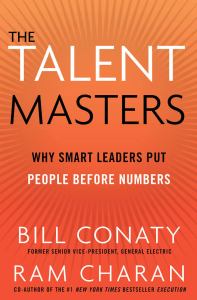 “If you think education is expensive, try ignorance.” – Derek Bok,
“If you think education is expensive, try ignorance.” – Derek Bok,
This sums up what I consider to be the bottom line of Talent Masters. Bill Conaty, former senior VP for Human Resources at General Electric under legendary leader and leadership developer Jack Welsh, and Ram Charan, prolific writer, educator, and coach to many leading companies, have teamed up to write this “Bible” on leadership talent development. Talent Masters argues persuasively that the main job of a CEO, and key leaders for that matter, is to develop future talent—emerging leaders who will create corporate value and who will take the current executives’ places when the time comes.
If talent is the leading indicator of whether a business is up or down,. . . do you know how to accurately judge raw human talent? Understand a person’s unique combination of traits? Develop that talent? Convert what supposedly are “soft” subjective judgments about people into objective criteria that are as specific, verifiable, and concrete as the contents of a financial statement? The talent masters do. They put people before numbers for the simple reason that it is talent that delivers the numbers. Success comes from those who are able to extract meaning from events and the forces affecting a business, and are able to look at the world and assess the risks to take and the risks to avoid.
“The Talent Masters” rests on three principles that characterize the Welch approach to management: (1) A focus on talent development. Mr. Welch and the other “talent masters” in the book—we also hear from folks at companies including Procter & Gamble and Novartis—claim that they spend more than a third of their time developing their people. (2) Differentiation. Talent masters create a meritocracy by constantly evaluating their people—a process which, in Mr. Welch’s case, was derided by critics as “rank and yank.” (3) Candor. This is the ultimate Welch trademark: ruthless honesty in evaluating the performance of people and businesses.
But the authors add to the Welchian wisdom by documenting some interesting examples. For instance, we learn about the day in 2000 when Larry Johnston, head of GE’s appliance business, flew to corporate headquarters in Fairfield, Conn., to tell his bosses that he was leaving to head up Albertsons, the supermarket chain. The news was a surprise to Mr. Conaty, to Jeff Immelt—who was then making a transition to the CEO job—and to Mr. Welch.All three tried to talk Mr. Johnston into changing his mind. But after determining that their effort was futile, the executives turned their attention to succession. Within a half-day they had agreed on who would replace Mr. Johnston and on who would fill three other slots down the chain of command. The quick action was possible, we’re told, only because the three men had been heavily involved in the continuous evaluation of the company’s top talent.
The authors compare GE’s rapid-fire performance in replacing Mr. Johnston with what happened recently at Hewlett Packard, when Mark Hurd was forced to step down after indiscretions involving a marketing consultant. The company, the book says, came “unhinged.” For the third time in little more than a decade, the HP board felt compelled to pick a chief executive from the outside—an implicit acknowledgment of failed succession planning.
Messrs. Conaty and Charan also show the forgiving side of Mr. Welch’s GE. They tell the story of Mark Little, who in 1995 was promoted to vice president of engineering at the company’s Power Systems group. Following his appointment, the group missed its numbers three times in a row, and Mr. Little was demoted. He suspected that his career at GE was over.Instead, executives there worked with Mr. Little to assure him that he still had a future and to help him rebuild his career in a position that made better use of his talents. Today he is the senior vice president in charge of the corporate R&D center, and one of the company’s top 25 executives.
The book begins with GE-related examples, but some of its most arresting stories come from outside the company. A particularly interesting chapter involves Hindustan Unilever, Unilever’s $3.5 billion Indian subsidiary. The company routinely evaluates candidates for management jobs by putting several applicants together to discuss a specific business issue in a group. This allows the company to see how they interact with each other and who has leadership potential.
Another instructive anecdote comes from Adrian Dillon, Skype’s chief financial officer. Mr. Dillon tells of how, early in his management career, when he was working at Eaton Corp., he was accosted after a meeting by his boss, the company’s CFO. “That was a great meeting, but your problem is that you still think your job is to be the smartest guy in the room. It’s not,” the man told him. Instead, Mr. Dillon was told, his job was to “make everybody in the room think that they’re the smartest guy in the room. You’ve got to teach them what you know and what you do, not tell them.”
Overall, “The Talent Masters” offers a valuable window into the skills of talent development. And it makes a persuasive case, yet again, for the wisdom of the Welch way. But you do have to wonder whether, a decade after Mr. Welch’s retirement, it isn’t time to find a new icon for the rapidly evolving world of business management.